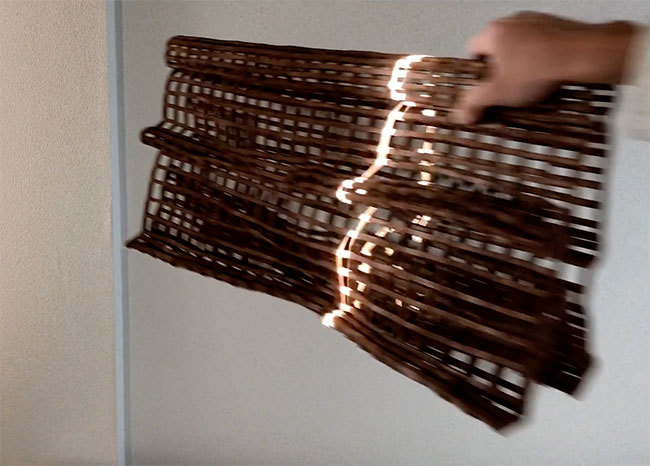Note: This website was automatically translated, so some terms or nuances may not be completely accurate.
The Cutting Edge of Japanese Media Art, Capturing the World's Attention
Japanese Works at the Ars Electronica Festival
Continuing from last time, we report on the Ars Electronica Festival, a global celebration of art, cutting-edge technology, and culture.
Last time, we covered works related to this year's festival theme, "Error: The Art of Imperfection." Another major highlight, separate from the themed exhibits, was the display of award-winning works from the Prix Ars Electronica art competition. This competition, with over 30 years of history, is widely recognized as the Oscars of the computer world.
Looking at the exhibition, there were many award-winning works from Japan. Particularly in the Interactive Art+ category of the Prix Ars Electronica, 5 out of 15 works were by Japanese artists.
Moreover, beyond just the award-winning displays, Japanese works were prominently featured throughout the entire festival, including the thematic exhibition mentioned earlier. So, what kind of Japanese works were being recognized and exhibited at the festival? We'll introduce some works from both the award-winning display and the thematic exhibition below.
Japanese Works Revealing Life as a Common Theme
● Robots conveying lifelike qualities through complex movement
Alter
Takashi Ikegami, Hiroshi Ishiguro, Kohei Ogawa, Itsuki Doi, Supported by Osaka University and Tokyo University
Award: Interactive Art+ Category: Award of Distinction
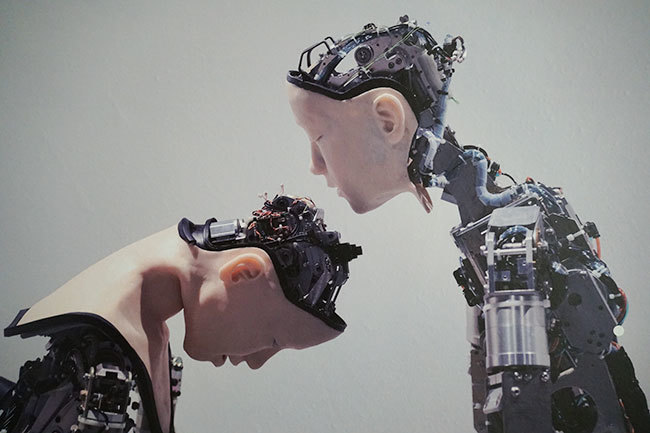
There exists a field called "artificial life" that explores what life is by creating forms of life that might have been possible. Its research spans a wide range, from software and chemical reactions to robots. "Alter" is a robotic work within this field of artificial life.
It was developed by a team including Professor Hiroshi Ishiguro of Osaka University, who researches androids, and Professor Takashi Ikegami of the University of Tokyo, who researches artificial life. Despite its exposed mechanical appearance, its smooth and complex movements forcefully convey a lifelike quality.
These movements are generated by neural networks—models mimicking the neural circuits of the human brain—and by CPGs (Central Pattern Generators), mechanisms modeled after systems that produce periodic movements like walking.
Furthermore, Alter constantly adapts its movements by reading its surroundings, exhibiting unpredictable behavior. To observers, this feels like Alter's own unique personality. This work poses the question: "Why does a machine, whose mechanisms and purpose differ from living organisms, sometimes feel more alive than living beings?"
●The resurgence of discarded electronics
Electronicos Fantasticos!
https://www.facebook.com/electronicosfantasticos/
Ei Wada ( https://eiwada.com/ ), Nicos Orchest-Lab
Award: Interactive Art+ Category: Honorary Mentions
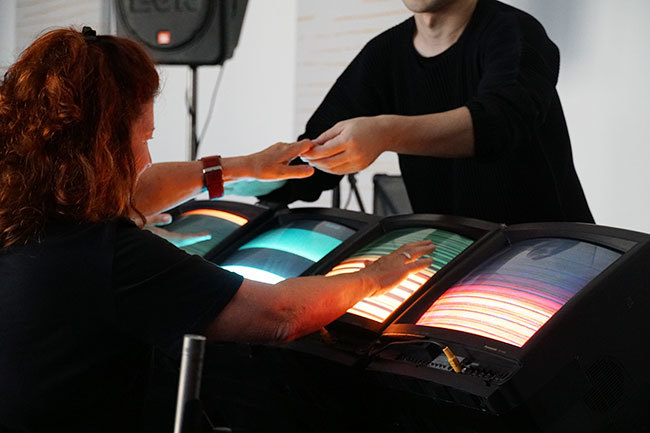
"Electronicos Fantasticos!" is a work that transforms old appliances into musical instruments. A cathode-ray tube TV becomes a drum, a fan becomes a guitar, and an air conditioner becomes a koto, all producing sound. The sound was described as if the unused appliances were raising a cry of revival. It evoked a worldview reminiscent of tsukumogami—spirits said to inhabit tools after many years of use.
At this festival, a live performance was held using these appliance instruments. Particularly striking was the mechanism where sound only emanated when performers and audience members linked hands in unison with the music. Here, hundreds of attendees linked hands, becoming one to produce the sound. I too linked hands with the foreigner beside me, experiencing the moment of transition from spectator to performer.
This performance was highly praised as the most exciting highlight of this year's festival.
●Life emerging from a single ray of light
Rediscovery of anima
Akinori Goto
Award: Computer Animation Category: Honorary Mentions
Click the image to view the work in video.
This work reveals shapes when a beam of light is directed at an object, and when the object is moved, the "motion" embedded within its form emerges. Artist Akinori Goto has previously presented works employing a similar technique of incorporating a time axis into objects.
Those works utilized modern technologies like 3D printers and projectors. This time, however, he employs primitive materials and methods—stone, branches, thread, and sunlight—demonstrating that similar expressions were possible centuries ago. It prompts the question: if this expressive technique had been discovered in the past, what kind of connection might it have formed with society?
For instance, in BC times it might have been used for magic or rituals, while in the 19th century it could have developed into entertainment. By tracing back through time, the work seeks to rediscover the form of "Anima" (the origin of the word "animation," meaning "life" or "soul") that might have existed.
While Ars Electronica often discusses things from a future perspective, this work approaches from the past. It was a piece that incorporated a temporal axis not only within the form of the object but also into its very concept.
●A hazy sphere of light
ObOrO
Ryo Kishi
Exhibition: Theme Exhibitions ERROR - Error, Fake & Failure -
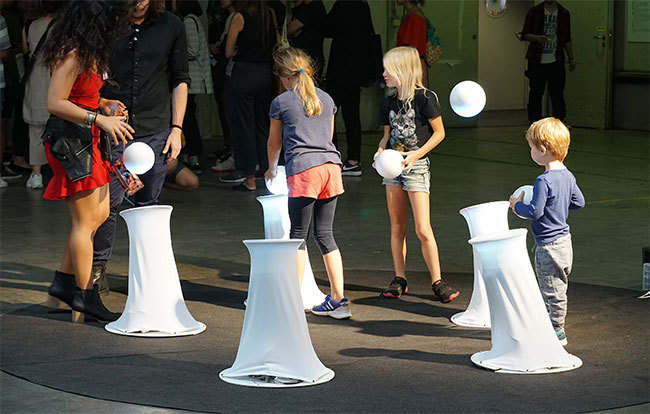
"ObOrO" is a work featuring a floating light installation. A light sphere, illuminated from below, is kept suspended in the air by a fan, creating unstable and accidental fluctuations. According to the artist, it was inspired by the vague, flickering motion of a candle flame, something that makes you instinctively want to hold your hand over it.
Indeed, without prompting, many people instinctively held their hands over the unsteadily swaying spheres. Their irregular movements also evoked a sense of living creatures. Children constantly gathered around the floating spheres, playing endlessly.
This work perfectly embodies the strengths of instability and fragility within this year's theme, "Error." Typically, unstable things are not intentionally placed around us. That's precisely why we find ourselves drawn to unstable things, captivated by them. Its placement at the entrance of the venue may have been intended to serve as a symbol showcasing the allure of error.
●Inflating soap bubbles to illuminate
Anima
Risako Kawashima, Yasuaki Kakehi
Exhibition: Theme Exhibitions ERROR - Error in Progress -
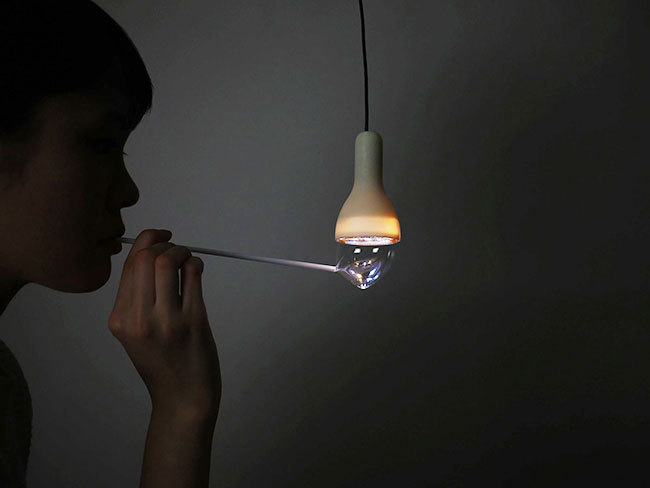
"Anima" is a work that inflates soap bubbles and illuminates them.
As noted earlier in "Rediscovery of anima," this title carries meanings such as "life" and "soul." Additionally, it also signifies "breath."
The participant blows a soap bubble toward the socket of a suspended light bulb. The electrically conductive soap solution then functions as part of the electronic circuit, causing the light to illuminate. However, after a few seconds, the soap bubble bursts, and the light goes out.
Similar to the "ObOrO" piece introduced earlier, I felt this was a light source embodying vitality and instability. Lighting it requires a slightly laborious action, evoking the image of breathing life into something. The bubble's fragility makes it clear the light has an end. It stands in stark contrast to the convenience of easily lit, everlasting light, yet precisely because of this, it was a work that evoked both affection and a sense of transience.
Differences Between Japanese and International Works: Unconsciousness and Consciousness
Now, I've selected five pieces from Japan. While other works utilizing robots and AI were also exhibited, the theme of "life" emerged as a defining characteristic.
Overseas artists exhibited works incorporating social themes like refugee issues, environmental problems, and surveillance societies. These pieces consciously prompt viewers to perceive and contemplate. In contrast, Japanese works often seemed to speak to the unconscious. The festival revealed a striking difference in characteristics between Japan and the rest of the world, beyond what I had imagined.
Now, over two installments, I've introduced works from the Ars Electronica Festival. The art world is often perceived as distant from business. However, as mentioned in the previous article, many people from the business sector visited seeking something new from art.
Similarly, the art world is also reaching out to business. For instance, Ars Electronica has hosted the STARTS PRIZE for several years now – a competition strongly focused on connections with industry and society. There, the expectation is that art, technology, society, and business will each spark positive chemical reactions.
The Ars Electronica Festival holds many hints for the future. It reveals the shape we should be heading towards through unexpected uses of technology, the discovery of previously unnoticed problems, and the many discussions sparked by these revelations. To confirm the direction of the future, why not take a step towards the field of art yourself?
Was this article helpful?
Newsletter registration is here
We select and publish important news every day
For inquiries about this article
Author

Toshiya Yui
Dentsu Inc.
BXCC
UX Designer / Creative Technologist
Born in Nagano Prefecture in 1993. Graduated from the Department of Expressive Engineering, Graduate School of Science and Engineering, Waseda University. Engages in planning, development, and experience creation rooted in technology. Also active as a media artist. Recipient of the Good Design Award, Art Hack Day 2018 Grand Prix, Alife 2018 Best Poster Award, among others. Exhibited "Escalator Museum" at Roppongi Art Night 2019.
